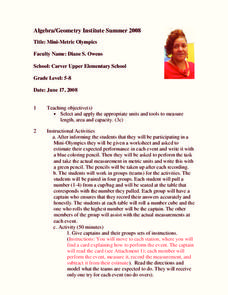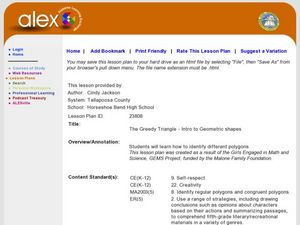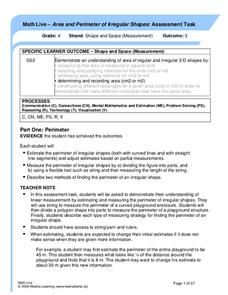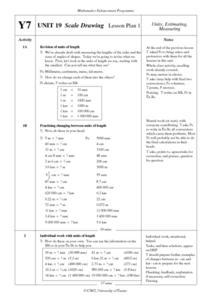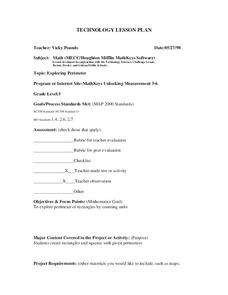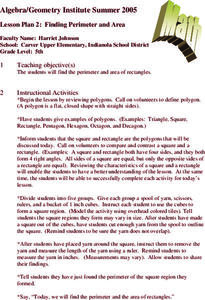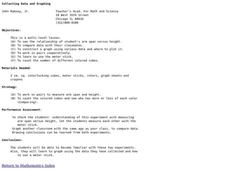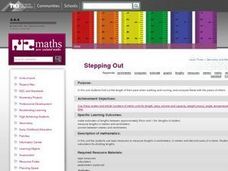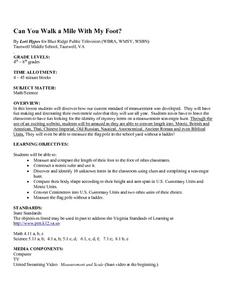Curated OER
Mini-Metric Olympics
Learners participate in a Mini-Olympics with measurements. In this measurement lesson, students throw items and predict how far they will go. They measure the actual distance and find the difference between that and their estimate.
Curated OER
The Greedy Triangle-Intro to Geometric Shapes
In this geometry lesson, learners read The Greedy Triangle and use geoboards to construct geometric shapes. They identify the number of sides and angles each shape has.
Alberta Learning
Area and Perimeter of Irregular Shapes
Evaluate young mathematicians' understanding of area and perimeter with this series of three assessment tasks. Challenging students to not only calculate the area and perimeter of irregular shapes, but to explain in writing their...
Curated OER
Problems!!!
In this word problems worksheet, students read word problems about one person telling the truth and one telling a lie and they figure out which is which. Students complete 4 problems.
Civil War Trust
Map the Civil War
Mapmaking was a very important element in successfully planning attacks on enemies during the Civil War. Guide pupils through the process of pacing to find the average length of their steps, measure the distance between one object...
Curated OER
Decimals Decide Olympic Champions
The class discovers how a decimal can make all the difference in the Olympics. As they learn about decimal place values, they compare and contrast data and demonstrate decimal values using manipulatives.
Curated OER
Does Sunlight Effect Leaf Size?
Students make estimates and then measure leaves for accuracy. They calculate the area of the leaves by drawing an outline on graph paper and counting the squares. They compare the leaves exposed to sunlight to those that are in constant...
Curated OER
Perimeter
Students study about perimeter and the units used to measure perimeter using a variety of materials including their hands, feet, rulers, and computer applets. They understand such attributes as length, area, weight, volume, and size of...
Curated OER
Scale Drawing Lesson Plan
Students calculate actual building measurements from a village map using concepts of ratios and scale in this ten activity mini-unit. They practice measuring angles, multiplying decimals, estimating height and length, and converting...
Curated OER
Volume of a Rectangular Prism
Children use the length, width, and height of an object to calculate the volume of a rectangular prism. They observe how to multiply three numbers at a time, and define volume. Pupils observe as the teacher demonstrates how to determine...
Curated OER
Problem Solving - Use a Formula 21.7
In this formula worksheet, students complete a graphic organizer, answering the questions relating to: understand, plan, solve, look back. Students solve 2 problems. Houghton Mifflin test is referenced.
Curated OER
Exploring Perimeter
Students explore perimeter. For this geometry and measurement lesson, students create squares and rectangles using given perimeters. Students construct four sided shapes with given perimeters using the computer program "Math Keys:...
Curated OER
Study Buddies: Classifying Triangles
In this math worksheet, students analyze an informative chart about the measurement and angles of equilateral, isosceles and scalene triangles. Students then answer 5 questions about classifying triangles.
Curated OER
Pacing a Gunther Chain
Students pace a Gunther Chain, a measurement used by foresters to determine distance and area. They discuss that pacing is individualized depending on age, gender, etc. They practice to find an average pace. Teams estimate, pace and...
Curated OER
How Long...?
Students explore measurement. They use appropriate units of measurement for different sized objects. Students collect their data and enter it into an Excel data base. They graph their findings and analyze their outcomes.
Curated OER
Finding Perimeter and Area
Geometers find the perimeter and area of rectangles. They discuss the definitions and characteristics of rectangles and squares. In groups, they use yarn to discover the perimeter of squares and rectangles. They count cubes to explore...
Curated OER
Geometric Shapes: Area and Perimeter
There's a reason this worksheet is done in groups! Tricky word problems give geometry scholars a challenge as they use prior knowledge about shapes to find the area and perimeter given a few measurements. Students will enjoy discovering...
Curated OER
Small Angle Calculations
Students work with circles, angles and estimating angles in the night sky. For this circles and angles lesson, students practice measuring a degree using the circumference of a circle and apply the degree to determine a way to use their...
Curated OER
Collecting Data and Graphing
Young mathematicians collect data and graph it. They work collaboratively to collect data regarding the span of arm length versus height and graph the data they collect.
Curated OER
Perimeter All Around
Students explore perimeter and area of regular and irregular polygons. They experiment with color squares and create different arrangements using the same number squares. Then they compare the area and perimeter measurements of each.
Curated OER
Stepping Out
Pupils calculate the length of their pace when walking and running and compare them with the other students' paces. Using tape measurers and calculators, they enter their data in a table, calculate the paces, and calculate the pace of a...
Curated OER
Can You Walk a Mile With My Foot?
Young scholars engage in a lesson that is concerned with the measurement of a foot as a customary unit. They take part in a series of activities to help them acquire skills of using a foot to compare other units of measurement. The...
Curated OER
Leveled Problem Solving Scale Drawings and Models
In this scale drawings activity, 5th graders learn to solve measurement problems using scale drawings and models for the six word problems.
Curated OER
Hands On: Centimeters and Millimeters
In this centimeter/millimeter learning exercise, learners estimate the length of pictures of tropical fish, then measure each to the nearest centimeter and use the measurements to solve 2 problems, then solve 2 additional problems.
